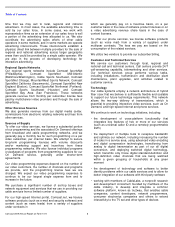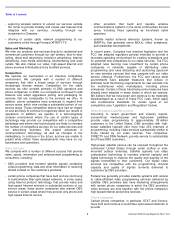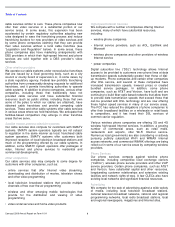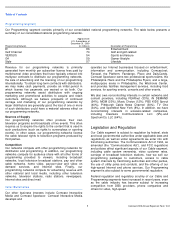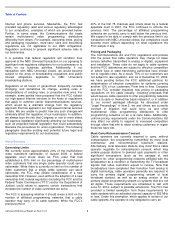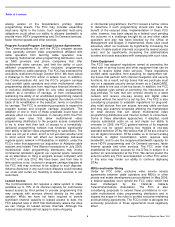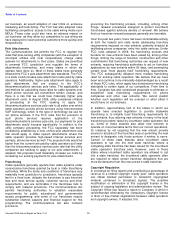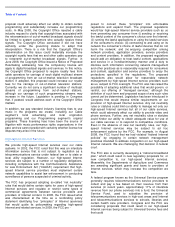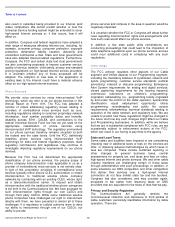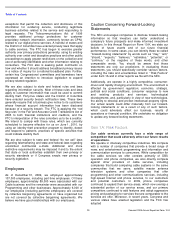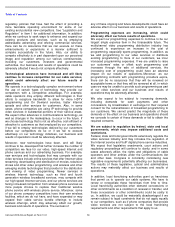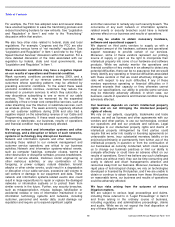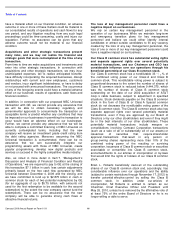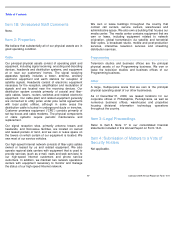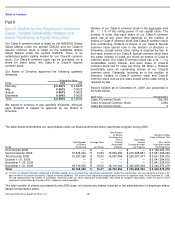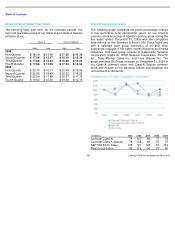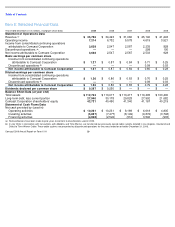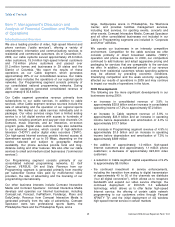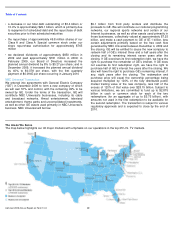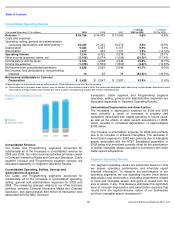Comcast 2009 Annual Report Download - page 19
Download and view the complete annual report
Please find page 19 of the 2009 Comcast annual report below. You can navigate through the pages in the report by either clicking on the pages listed below, or by using the keyword search tool below to find specific information within the annual report.
Table of Contents
13
Comcast 2009 Annual Report on Form 10-
K
exceptions that permit the collection and disclosure of this
information for rendering service, conducting legitimate
business activities related to the service and responding to
legal requests. The Telecommunications Act of 1996
provides additional privacy protections for customer
proprietary network information, commonly known as CPNI,
related to our digital phone services. A handful of states and
the District of Columbia have enacted privacy laws that apply
to cable services. The FTC has begun to exercise greater
authority over privacy protections generally, using its existing
authority over unfair and deceptive practices and other public
proceedings to apply greater restrictions on the collection and
use of personally identifiable and other information relating to
consumers. The FCC also is seeking public comments on
how and whether it should address broadband privacy issues
in a notice of inquiry for a national broadband plan. Further,
certain key Congressional committees and lawmakers have
expressed an intention to introduce legislation to expand
privacy-related regulation.
We are also subject to state and federal rules and laws
regarding information security. Most of these rules and laws
apply to customer information that could be used to commit
identity theft. Forty-five states and the District of Columbia
have enacted security breach notification laws. These laws
generally require that a business give notice to its customers
whose financial account information has been disclosed
because of a security breach. The FTC is applying the “red
flag rules” in the Fair and Accurate Credit Transactions Act of
2003 to both financial institutions and creditors, and the
FTC’s interpretation of the rules considers us to be a creditor.
We intend to comply with these rules, which are currently
scheduled to become effective for us on June 1, 2010, by
using an identity theft prevention program to identify, detect
and respond to patterns, practices or specific activities that
could indicate identity theft.
We are also subject to state and federal “do not call” laws
regarding telemarketing and state and federal laws regarding
unsolicited commercial e-mails. Additional and more
restrictive requirements may be imposed if and to the extent
that state or local authorities establish their own privacy or
security standards or if Congress enacts new privacy or
security legislation.
Employees
As of December 31, 2009, we employed approximately
107,000 employees, including part-time employees. Of these
employees, approximately 89,000 were associated with our
Cable business and the remainder were associated with our
Programming and other businesses. Approximately 6,000 of
our employees (including part-time employees) are covered
by collective bargaining agreements or have organized but
are not covered by collective bargaining agreements. We
believe we have good relationships with our employees.
Caution Concerning Forward-Looking
Statements
The SEC encourages companies to disclose forward-looking
information so that investors can better understand a
company’s future prospects and make informed investment
decisions. In this Annual Report on Form 10-K, we state our
beliefs of future events and of our future financial
performance. In some cases, you can identify these so-called
“forward-looking statements” by words such as “may,” “will,”
“should,” “expects,” “believes,” “estimates,” “potential,” or
“continue,” or the negative of these words, and other
comparable words. You should be aware that those
statements are only our predictions. In evaluating those
statements, you should specifically consider various factors,
including the risks and uncertainties listed in “ Risk Factors”
under Item 1A and in other reports we file with the SEC.
Additionally, we operate in a highly competitive, consumer
-
driven and rapidly changing environment. The environment is
affected by government regulation; economic, strategic,
political and social conditions; consumer response to new
and existing products and services; technological
developments; and, particularly in view of new technologies,
the ability to develop and protect intellectual property rights.
Our actual results could differ materially from our forward-
looking statements or as a result of any of such factors,
which could adversely affect our business, results of
operations or financial condition. We undertake no obligation
to update any forward-looking statements.
Item 1A: Risk Factors
Our cable services currently face a wide range of
competition that could adversely affect our future results
of operations.
We operate in intensely competitive industries. We compete
with a number of companies that provide a broad range of
news and entertainment programming and information and
communication services to consumers. While competition for
the cable services we offer consists primarily of DBS
operators and phone companies, we also directly compete
against other providers of cable services, including
companies that build competing cable systems in the same
communities that we serve, satellite master antenna
television systems and other companies that offer
programming and other communications services, including
high-speed Internet and phone services, to our customers
and potential customers. In 2009, phone companies
continued to expand their service areas, which now overlap a
substantial portion of our service areas, and our primary
competitors continued to add features and adopt aggressive
pricing and packaging for services that are comparable to the
services we offer. Moreover, in recent years, Congress and
various states have enacted legislation and the FCC has
adopted


